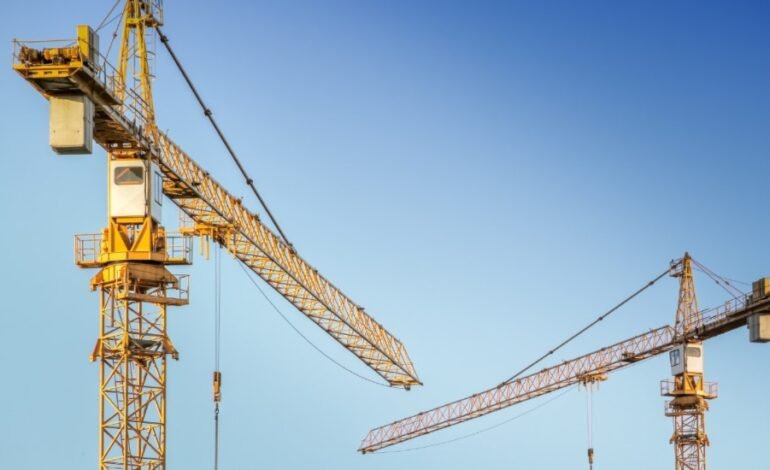Crane Parts: Understanding the Essential Components

Cranes are complex machines used for lifting and moving heavy loads in industries such as construction, manufacturing, and shipping. The effective operation of a crane depends heavily on its individual parts, each serving a unique purpose in ensuring safety and performance. Understanding the critical crane parts is key to operating and maintaining these machines properly. These components work together to allow cranes to perform heavy lifting, often in challenging environments.
Knowing the crane parts and how they function can not only help operators ensure smoother operations but also prevent costly breakdowns and safety incidents. Proper maintenance and knowledge of each component are vital for prolonging the life of a crane and ensuring it meets safety regulations.
The Core Components of a Crane
Cranes consist of several essential parts that all work in harmony to achieve their lifting capabilities. These crane parts are generally categorized into the structural elements, mechanical systems, and control systems. Each component is crucial for ensuring that cranes function as intended, enabling safe and efficient lifting of heavy loads.
One of the most vital parts of a crane is the boom. The boom is the long, arm-like structure that supports the load during lifting. It is typically made of steel and can be extended or retracted depending on the task at hand. A boom’s design can vary based on the type of crane, with telescopic booms being a common choice for versatility.
The hoist mechanism is another critical component in crane operations. The hoist is responsible for lifting and lowering the load, often using a system of ropes or chains. This part is connected to the motor and hydraulic systems, making it an essential element for effective load handling. The hoist’s strength and capacity directly influence the crane’s lifting capabilities.
Another important part is the counterweights. These weights are placed on the crane to balance out the load being lifted. Without counterweights, the crane may become unstable, especially when lifting heavy objects. These weights are designed to prevent tipping and ensure that the crane maintains its balance, no matter the load’s weight or height.
The turntable is a crucial part of the crane’s base structure. It allows the crane to rotate in a circular motion, providing flexibility in positioning and load placement. The turntable works in conjunction with the slewing mechanism, which is responsible for the rotation of the crane. Proper maintenance of this component ensures smooth movement and efficient operation.
The hook is another critical crane part that attaches the load to the crane. While this part may seem simple, it plays a vital role in safely securing the load during the lifting process. Hooks are typically made of high-strength materials to withstand the pressure of lifting heavy objects and are designed to be easily attached or detached to improve efficiency.
Importance of Quality Crane Parts for Safety and Efficiency
When it comes to crane operations, the quality of the parts directly impacts the machine’s performance and safety. Quality crane parts ensure that the machine can lift and move heavy loads without failure. Additionally, superior components can reduce the likelihood of breakdowns, which can lead to downtime and costly repairs.
Safety is a primary concern when it comes to crane operations. Each part of the crane plays a role in ensuring that lifting operations are carried out safely. For instance, high-quality hydraulic systems are essential for controlling the lifting and lowering of loads with precision. A failure in any of these systems, such as a hydraulic leak or malfunctioning brake, could result in catastrophic accidents, including the dropping of a load or crane tip-over.
The use of subpar crane parts can also lead to operational inefficiencies. Low-quality parts may wear out faster, resulting in more frequent maintenance or replacements. This can lead to unnecessary downtime, which is costly for businesses that rely on cranes for daily operations. Investing in durable, high-quality parts may come with a higher initial cost, but it will pay off in the long term by reducing the frequency of repairs and maintaining a high level of productivity.
Routine inspections and timely replacement of worn-out crane parts are vital for ensuring a crane’s efficiency. These checks can identify potential issues before they become more severe problems. For example, checking the hoist system for wear and tear, ensuring the proper function of the brakes, and confirming the health of the hydraulic systems can all help prevent unexpected breakdowns.
How to Maintain Crane Parts for Longevity and Performance
Maintenance is essential for keeping crane parts in optimal working condition. Regular care and inspection can significantly extend the lifespan of a crane and its components. One of the most important aspects of crane maintenance is monitoring the hydraulic system. This system powers many parts of the crane, including the hoist and boom, and it requires regular inspection for leaks or degradation. Hydraulic fluid levels should be checked frequently, and any abnormalities should be addressed immediately to prevent further damage.
Another area that requires attention is the cables and ropes used in the hoisting process. These components endure significant wear during crane operations and can become frayed or damaged over time. Operators should monitor the condition of the ropes, checking for signs of wear, abrasions, or corrosion. If any issues are found, the ropes should be replaced promptly to ensure that the crane can continue to operate safely.
The brake system of a crane is another crucial part that requires regular inspection. The brakes are responsible for securing the load and stopping the crane when needed. Over time, the brake pads can wear down, making them less effective. Ensuring that the brakes are in good condition is essential for preventing accidents and ensuring that the crane can operate at full capacity.
Inspecting the electrical systems is also important. Cranes are powered by complex electrical systems that control various parts, such as the motor, winch, and hydraulic pumps. Electrical components can experience wear, which can lead to malfunction. Regular checks of wiring, circuits, and connections can help prevent electrical failures.
Furthermore, operators should pay close attention to the bearings and joints in the crane’s mechanical systems. These parts allow movement and rotation within the crane and must be lubricated regularly to reduce friction and wear. If these parts become dry or damaged, the crane’s movement can become jerky, which may interfere with its lifting capabilities and lead to additional wear on other components.
Maintaining Crane Parts with Routine Inspections
Ensuring that crane parts remain in optimal condition involves routine checks and proper documentation. Inspections should be conducted by trained professionals who can identify potential risks and ensure that all crane parts meet safety standards. Operators should follow the manufacturer’s maintenance schedule for the crane and replace worn parts before they become a safety risk. Implementing a comprehensive maintenance plan helps extend the life of the crane, minimizes downtime, and ensures that the crane operates smoothly, allowing it to perform its tasks safely and efficiently.
By understanding the importance of each crane part, operators can maintain their equipment properly, avoid unnecessary costs, and ensure safe lifting operations. The safety of a crane operation relies on the proper functioning of each individual component, from the boom to the counterweights. Understanding the roles and functions of crane parts can help operators spot problems early, implement effective maintenance strategies, and ensure that the crane continues to perform at its best.
Maintaining crane parts is not just about preventing breakdowns but also about creating a safer working environment. By keeping up with inspections and replacing parts when needed, crane operators contribute to the safety and efficiency of their operations. Quality crane parts and regular maintenance are essential investments for any business that relies on cranes to perform heavy lifting tasks.












